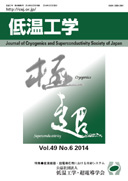All issues

Volume 49, Issue 6
Displaying 1-7 of 7 articles from this issue
- |<
- <
- 1
- >
- >|
Preface
-
Kenichi SATO2014Volume 49Issue 6 Pages 279
Published: June 25, 2014
Released on J-STAGE: July 11, 2014
JOURNAL FREE ACCESSDownload PDF (597K)
Feature: Cooling Systems for Industrial Equipment and Applications of Superconductivity
-
Yoshiki MIYAZAKI2014Volume 49Issue 6 Pages 286
Published: June 25, 2014
Released on J-STAGE: July 11, 2014
JOURNAL FREE ACCESSDownload PDF (531K)
Review Article
-
―Available and Required Cooling Systems―Yasuharu KAMIOKA2014Volume 49Issue 6 Pages 287-294
Published: June 25, 2014
Released on J-STAGE: July 11, 2014
JOURNAL FREE ACCESSThe cooling system of high-temperature superconductivity (HTS) applications has become the most important issue in this field nowadays. Some HTS applications are mostly developed as systems that have an established place in our society. However, cooling systems are not developed for the HTS applications and are still in the experimental stage. Cooling systems should be developed as systems which can be used in the commercial world. In this paper, cooling systems, refrigerators and pumps were described and the available and the required cooling systems were shown.View full abstractDownload PDF (4312K)
Focused Reviews
-
Naoki HIRANO, Tomonori WATANABE, Shigeo NAGAYA2004Volume 49Issue 6 Pages 295-300
Published: June 25, 2004
Released on J-STAGE: July 11, 2014
JOURNAL FREE ACCESSAs energy storage equipment for electric power systems, superconducting magnetic energy storage (SMES) systems have good characteristics such as high efficiency, quick response and no deterioration under repeated operations. Since 1991, a national project by the Agency for National Resources and Energy Japan has been carried out to develop an SMES system for power control in a power system. Moreover, SMES has been developed as a bridge for instantaneous voltage dips since 2003. In this issue, cooling systems and cryocoolers for SMES are introduced.View full abstractDownload PDF (2804K) -
Shoji TSUNEMATSU, Katsuhiro NARASAKI, Akinobu OKABAYASHI, Kiyomi OTSUK ...2014Volume 49Issue 6 Pages 301-306
Published: June 25, 2014
Released on J-STAGE: July 11, 2014
JOURNAL FREE ACCESSThe superconducting submillimeter-wave limb-emission sounder (SMILES) was operated aboard the Japanese experiment module (JEM) of the International Space Station (ISS). SMILES uses two superconductor-insulator-superconductor (SIS) mixers for submillimeter-wave atmospheric observation, and they are cooled to 4 K levels by a cryogenic system with a two-stage Stirling cycle cooler, a Joule-Thomson (JT) cycle cooler and a cryostat composed of three stages (4 K, 20 K and 100 K). SMILES was launched on September 11, 2009 (UT) from the Tanegashima Space Center (TNSC). The cryogenic system reached 4.1 K in approximately 70 hours after it began to be cooled, and the observation was performed. The cryogenic system has electric drive power of less than 70 W, and continued cooling for 6,010 hours at 4 K levels.View full abstractDownload PDF (5177K) -
Masaru TOMITA2014Volume 49Issue 6 Pages 307-310
Published: June 25, 2014
Released on J-STAGE: July 11, 2014
JOURNAL FREE ACCESSDC electric railway systems are widely used in Japan, including in metropolitan areas. However, they have some problems, such as limited use of regenerative brakes and energy losses. In order to solve those problems, and to attain the energysavings essential for next-generation electric railway systems, we have been studying the feasibility of applying superconducting power cables to DC electric feeder systems. In this study, the design and specifications of a cooling system which are required for the superconducting cables for railway systems are shown.View full abstractDownload PDF (1209K)
Original
-
– Feasibility of Heat Load Mitigation Process Control –Ryuji MAEKAWA, Shigeyuki TAKAMI, Koki OBA, Akifumi IWAMOTO, Hyun-Sik C ...2014Volume 49Issue 6 Pages 311-318
Published: June 25, 2014
Released on J-STAGE: July 11, 2014
JOURNAL FREE ACCESSA substantial dynamic heat load of approximately 50 kW with 1800s periodic variation on a cryoplant is expected during Deuterium-Tritium (DT) operation for ITER Tokamak. To reduce the impact on cryoplant operation, the heat load mitigation technique has been proposed to suppress peak-to-peak heat load variation as utilizing the massive Toroidal Field (TF) coil structure (approximately 4000 tons) as a thermal buffer. Two heat load mitigation schemes are being under consideration; one is utilization of a bypass valve for Heat eXchanger (HX) to reduce the thermal energy dissipation at HX, the other is regulation of massflow rate in the cooling loop via cold circulator speeds to impose a time lag for the heat transfer rate at HX. Feasibility tests were successfully completed with the HElium Loop for hIgh lOad Smoothing (HELIOS) facility at CEAGrenoble under the frame work of ITER technical service contract. At the same time, the dynamic simulation model has been developed with a Cryogenic-Process REal time SimulaTor (C-PREST) at NIFS to validate the model against HELIOS data. C PREST has been utilized to model LHe plant which does not have modules to reproduce the thermo-hydraulic behavior of SHe cooling loop. Two unit modules, SHe process piping and SHe circulator, have been developed to implement HELIOS facility in C-PREST. The developed model demonstrated its robustness as reproducing the experimental results fairly well.View full abstractDownload PDF (5751K)
- |<
- <
- 1
- >
- >|